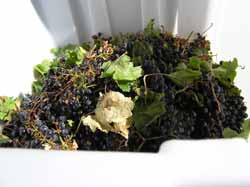Here is Zelma's update on all fronts:
Weather: The weather has been perfect this last week; cool nights and warm days. Next week rain is projected for Tuesday and Thursday. We will see what really will happen! Weather changes frequently in the Cape.
Sorting: After the vineyard check, Julie and I went to help Bernard with the sorting. Block E had a lot of raisins; fortunately no small green berries (like we saw in the Cab Franc). But it took "heavy sorting" - Bernard and I doing cluster sorting; 9 women on the sorting belts, and Julie at the end, just before the grapes fall in, to catch anything we missed.
Fermentations: As of today we will have 2 tanks on cold soak (Merlot and Cabernet Franc); 1 actively fermenting tank (Merlot) just in the midst of fermentation; 2 tanks finishing fermentation (Merlot Z and Malbec) and one (Merlot AB - our first harvest) in barrels finishing fermentation. In addition to overseeing grape reception, destemming, sorting and crushing, Bernard oversees these fermenters, making sure their temperature what we want; that the mixing morning, noon, and night, is what we should do…(and it is different for each tank, both in timing, duration, and type…we decide as we taste together and discuss each morning).Other winery work:We anticipate pressing out the Malbec on Tuesday; today Bernard is organizing the barrels to be filled. I select the barrels for use based on my past experience with our Malbec. I have tried several types of new barrels and someolder barrels, and prefer the older barrels with this wine. It has so much fruit that we want the fruit to be forward, and it is so lush it doesn't need, or benefit from, the new oak.
Baby grape sitting: To the parents out there, it often feels like we are watching over our "babies" …some of them fermenting; some still "hanging out" in the field; and some being separated from their skins (pressing); but all needing daily and usually multidaily attention.
Zelma Long



































